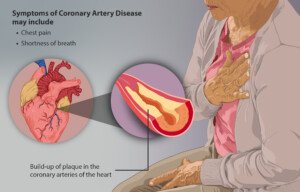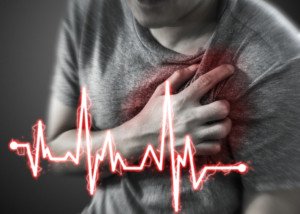Women and men are so different and this includes with angina symptoms.
Angina is when the heart muscle does not receive adequate blood flow (and therefore oxygen), as a result of narrowed coronary arteries.
The resulting classic symptoms are chest pain and shortness of breath, especially upon physical exertion or emotional stress.
“Both men and women experience angina (chest pain or discomfort) due to blockage in the coronary arteries that supply the heart muscle,” says Gordon A. Ewy, MD, Director Emeritus, University of Arizona Sarver Heart Center.
A myocardial infarction is when blood flow fails to reach heart muscle due to a completely blocked artery, thereby damaging the tissue.
Dr. Ewy says that men are more likely to have an MI as their initial symptom of heart disease.
“In men, atherosclerosis (combination of cholesterol, scar tissue and inflammatory cells) causes angina by narrowing the coronary artery,” says Dr. Ewy. For women it’s different.
“In women, angina is often due to blockages caused by coronary spasm, in which the muscles in the coronary artery contract, making the artery smaller in one area and limiting blood flow to the heart muscle,” explains Dr. Ewy.
A CT coronary angiogram is used to detect blockages in large coronary arteries.

myupchar. com
This imaging test can therefore miss the problems that cause women’s angina.
“As a result, many women with positive stress tests and angina previously were told there was nothing wrong with their hearts because their coronary angiograms were normal.”
What’s even scarier is that the gold standard for identifying coronary artery blockages, the invasive catheter angiogram, may actually miss blockages in the smallest of the heart’s vessels.
So how can such small-scale, but significant, blockages be detected?
Dr. Ewy says by sophisticated MRI cardiac chemical stress tests. Angina is just harder to detect in women versus men.
Symptoms of angina in men differ than those of women.
“Recent studies have shown that unlike angina in men, most often characterized by chest or left-arm discomfort, angina in women often presents as weakness, fatigue, shoulder, stomach or back pain or shortness of breath,” says Dr. Ewy.
What about treadmill stress tests?
They are more likely to generate false positives in women (the identification of a blockages that’s non-existent).
Dr. Ewy explains: “While 25 percent of men with angina suffered heart attacks within five years, heart attacks occurred in only 17 percent of women with angina.
“In all studies of heart attacks due to total or near-total blockage of a coronary artery, 75 percent were men and 25 percent women.
“Thus, the classic heart attack is three times more common in men; yet, when women do have a heart attack, their mortality rate is higher.”
 In the area of research, Dr. Ewy has made significant contributions to the defibrillation and resuscitation of patients with cardiac arrest. He is board certified in internal medicine and cardiology and has authored over 400 publications in medical journals.
In the area of research, Dr. Ewy has made significant contributions to the defibrillation and resuscitation of patients with cardiac arrest. He is board certified in internal medicine and cardiology and has authored over 400 publications in medical journals.
 Lorra Garrick has been covering medical, fitness and cybersecurity topics for many years, having written thousands of articles for print magazines and websites, including as a ghostwriter. She’s also a former ACE-certified personal trainer.
Lorra Garrick has been covering medical, fitness and cybersecurity topics for many years, having written thousands of articles for print magazines and websites, including as a ghostwriter. She’s also a former ACE-certified personal trainer.
.










































